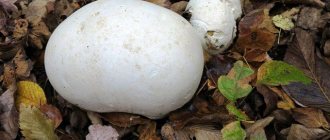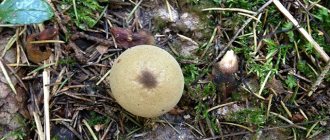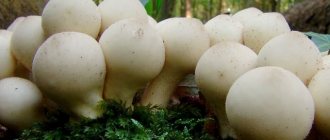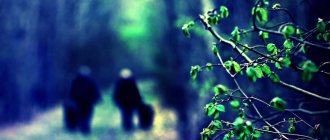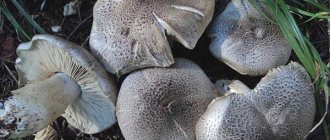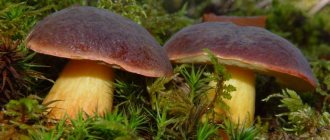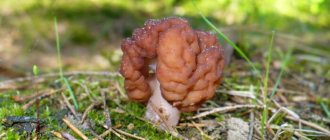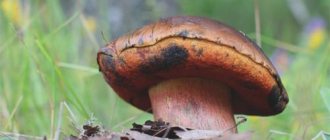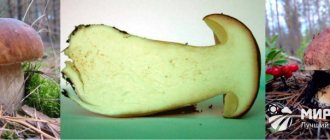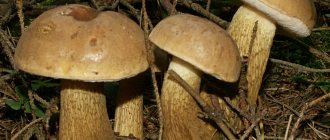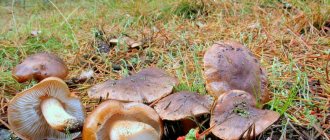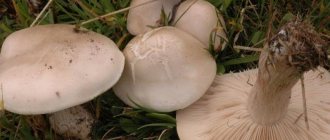Mushrooms
0
1825
Article rating
Kira Stoletova
All types of mushrooms are conventionally divided into groups based on external structural features. Tubular mushrooms are especially popular, the representatives of which are distinguished by their attractive appearance, strong pleasant aroma and high taste.
Characteristics of tubular mushrooms
General information about rows
Before we move on to the description and photo of the sulfur row, we will present general information about all the row mushrooms. Several externally similar genera of the Ryadovaceae family have this name in Rus'. But some mushrooms of other genera of the same family can be called in the same way.
To a greater extent, these are fungi of the genus Tricholoma. For example, purple, lilac-footed and violet belong to the genus Lepista, and the May row belongs to the genus Calocybe. Moreover, these mushrooms can be classified as different genera only by microbiological characteristics, but according to external data, they are almost all similar - the same shape, they grow in rows, the same smell. Mycological scientists themselves cannot make up their minds, which is why many of the species wander among different genera. Their main characteristic is that they grow in groups (rows).
You can get acquainted with one of the types of mushrooms - the sulfur row (photos and descriptions are presented in the article) by reading the material presented below. It is very important for mushroom pickers to know that among them, unfortunately, there are also poisonous ones, although not fatal. The worst that can happen is long-term intestinal upset. Unfortunately, although these mushrooms are common, they are difficult to identify.
This genus received its name for its characteristic growth pattern - in groups (in a row or in rings).
Ryadovki is a numerous genus of mushrooms, in which there are more than 2.5 thousand species. For mushroom pickers, only a few species are of particular interest - about 5, of which only 3 species are classified as edible and 2 as conditionally edible.
Division of rows into edible and poisonous species
Among the edible rows of mushroom pickers, the following species may be of interest:
- gray row (description and photo are presented in the article);
- crowded;
- poplar;
- green (greenfinch);
- May (May mushroom).
Among the conditionally edibles that may be useful:
- purple;
- yellow-brown;
- yellow-red.
The remaining species of this genus of mushrooms belong to inedible varieties of mushrooms and even to poisonous ones (especially tiger row). In this regard, only the most experienced mushroom pickers collect them for consumption. For the rest, it’s better not to collect them and avoid them altogether.
Gray row: photo and description
Tricholoma portentosum is a common edible, relatively large mushroom. The gray rower got its name, as noted above, for its ability to grow in rows and rings and for the gray color of the cap. It is often called the hatched or little mouse because of its resemblance at a young age to a small gray mouse. It belongs to the lamellar mushrooms.
What does a gray row look like? The spores necessary for the reproduction of this fungus are found in the plates. The latter are wide in shape, very sparse, slightly sinuous. In young mushrooms they are almost white, while in more mature ones they are gray, with a yellowish tint. The cap of the gray row is fleshy with wavy edges and slightly noticeable blackish radial fibers. Young mushrooms have rounded conical caps, while mature ones are uneven, often spread out, with a flat tubercle in the center. And the edges of the caps of young mushrooms are slightly curled, while those of mature ones crack over time, bending upward.
Based on the color of the cap, they are mostly a pale grayish or dark gray shade, but are often found with violet, olive and lilac shades. The surface is smooth, slimy and sticky in wet weather, which is why leaves and grass stick to it. The stem of the gray row is slightly thickened, cylindrical in shape, smooth and dense, longitudinally fibrous and deeply set in the foliage or moss. The gray-yellow-white flesh in the cap is dense, but rather brittle, and in the stem it is loose and fibrous.
It is believed that the mushroom has a mild, persistent powdery odor and taste. However, there is an opinion among mushroom pickers that its smell is more like the smell of stale, damp and musty flour, and it is definitely not spicy.
Autumn row mushroom. The gray hat is clearly visible in the autumn forest. Some specimens can be found in the summer (August), but the row is especially numerous in the fall (September-October).
It is believed that this mushroom has the best taste among all edible varieties of rows.
Historical discoveries
It is believed that yeast has been used as an industrial microorganism for thousands of years and that the ancient Egyptians used its fermentation to grow bread.
There are grinding stones, baking chambers and carvings believed to be bakeries that date back thousands of years, and even archaeological excavations have uncovered supposed jars containing remains of wine.
According to history, these single-celled fungi were first visualized with high-quality lenses around 1680 by Antonie van Leeuwenhoek.
However, he thought that these globules were grain starch particles used to make wort (a liquid extract used in brewing), rather than yeast cells for fermentation.
Later, in 1789, a French chemist named Antoine Lavoisier contributed to the understanding of the basic chemical reactions required to produce alcohol from sugar cane.
This was achieved by estimating the proportion of materials and feedstocks (ethanol and carbon dioxide) after the addition of yeast paste. However, at the time it was believed that the yeast was simply there to start the reaction, rather than being fundamental throughout the entire process.
Also in 1815, French chemist Joseph-Louis Gay-Lussac developed methods for maintaining grape juice in an unfermented state and discovered that the introduction of an enzyme (containing yeast) was necessary to convert the unfermented must, demonstrating the importance of yeast for alcoholic fermentation. Then Charles Cagnard de la Tour in 1835 used a microscope with greater power to prove that yeasts are single-celled organisms and reproduce by germination
Then Charles Cagnard de la Tour in 1835 used a microscope with greater power to prove that yeasts were single-celled organisms and reproduced by germination.
By the 1850s, Louis Pasteur discovered that fermented drinks were the result of the conversion of glucose into ethanol by yeast and defined fermentation as "breathing."
To discover zymase, Eduard Buchner in the late 1800s used cell-free extracts obtained by grinding yeast, collecting enzymes that stimulate or catalyze fermentation. He was awarded the Nobel Prize in 1907 for this research.
Between 1933 and 1961, Øyvind Winge, known as the "father of yeast genetics", together with his colleague Otto Laussen, developed methods for micro-manipulating yeast and were thus able to study it genetically.
Since then, many other scientists have conducted innovative research, and several have been awarded the Nobel Prize for significant discoveries, including: Dr. Leland Hartwell (2001); Dr. Roger Kornberg (2006); Drs Elizabeth Blackburn, Carol Greider and Jack Szostak (2009), and more recently Drs Randy Schekman, James Rothman and Thomas Sudhof (2013) and Dr Yoshinori Ohsumi (2016).
How to distinguish an inedible mushroom from an inedible one?
There are many mushrooms similar to the gray row. Among several species there are poisonous gray rowers, so before collecting them, you should carefully study their similarities and differences.
The most similar to the gray row is the pointed row. It is inedible due to its bitter taste. She has exactly the same gray hat, which is also cracking at the edges. But in this mushroom, the center of the cap is a pointed, strongly protruding tubercle. It can be distinguished by both its pulp and its plates: the pointed one is grayish-white, and the gray one is yellowish-white. And the pointed row is thinner and smaller in size, and it does not grow in large clusters, like the gray edible one.
Sanghwan
The Sanghwan mushroom is a type of Polypore. This is a woody mushroom that lives on deciduous trees. The most prized is Sanghwan, collected from rowan, alder and chestnut. In Russia, few people know this mushroom, although it is highly valued in oriental medicine. Sanvhan will help with both gastrointestinal diseases and has a good general strengthening effect. But the most important are its antitumor properties. Sanghwan is very effective during chemotherapy. Scientists at Boston University have conducted a number of studies on the fungus in this regard. Sanghwan's polysaccharide complex has a destructive effect on cancer cells. It suppresses their development and greatly weakens them, which makes chemotherapy more effective. The fungus facilitates easier penetration of chemotherapy drugs into cancer cells. At the same time, the same polysaccharides protect healthy cells of the body. Studies have proven that taking Sanghwan during chemotherapy greatly enhances its effect and reduces the negative consequences for the body.
Brief description of some similar species
As noted above, among the rows there can be inedible, edible and poisonous (weakly poisonous) mushrooms:
- the earthy row (semi-edible), characterized by its smaller size, sparse plates and fibrous scaly surface of the cap;
- different row (semi-edible), having an unpleasant odor and a green, brown or white stem;
- soap row (inedible), colored more evenly and having a strong smell of laundry soap;
- the row is pointed (weakly poisonous), distinguished by a thin ashy cap, with a noticeable conical tubercle in the middle, as well as a burning pulp to taste;
- tiger row (large and very poisonous), distinguished by a gray cap covered with black spotted small scales and flesh, which turns pink when touched and cut, especially at the stem.
Signs of the cap edge
The edge of the cap is a continuation of its central part and its shape in many cases is an important feature necessary for accurate identification of the mushroom, and also carries information about the structure and development of the fruiting body. On the cross section of the cap, the following shapes of its edge are distinguished:
The shape of the edge of the cap can change greatly with the age of the fruiting body: if the edge is tucked in or bent down, it unfolds and becomes more and more straight; in old mushrooms it curls up, and the area of the hymenophore increases. The edge trim also changes: if at first it is usually equal, then with age it can become wavy, lobed, lobed-dissected, this also serves to increase the area of the hymenophore.
The edge may be sterile if the hymenophore ends before reaching it.
The presence and type of private cover are determined by the fibers, membranous flaps, and lumps of mucus on the edge of the cap.
Where does the gray row grow?
The mushroom usually grows in the temperate zone of the northern hemisphere: in Canada, North America, Western, Northern and Eastern Europe, and the Far East. Main Russian regions of growth: Central Russia, the Urals, Siberia (Novorossiysk), Crimea.
The fruiting period, as a rule, begins in early September and ends during frost (late November). The most widespread fruiting occurs from the end of September to the first half of October.
The gray edible row is most common in coniferous (especially pine) and mixed forests and, as a rule, on sandy soil, in mosses and under deciduous-coniferous litter. It grows not only in groups. It is often found in the same places where greenflies are found, and their growth period is simultaneous. It is popularly believed that the described row is almost the sister of the green grass, which is why it is sometimes called the green grass.
Attention, danger - poisonous tubular mushroom false boletus
The only representative of tubular mushrooms that can harm humans is the satanic mushroom. It was not by chance that he gained their trust, because outwardly he has the maximum resemblance to a real boletus, as a result of which mushroom pickers call it “false boletus.”
His hat is in the shape of a hemisphere, with a smooth grayish skin, slightly velvety. The dense stem resembles a barrel, is orange at the top and slightly tapers. The center of the stem of the poisonous tubular mushroom is decorated with a red mesh, turning into a yellow-brown color near the ground.
You can distinguish a false boletus from a real one by the bluish flesh after a cut, which first turns red. In addition, the middle part of the leg has a brightly colored red mesh.
Application
Despite its unprepossessing appearance, the gray row has a fairly high taste. The described mushroom is suitable for a variety of types of processing. It can be frozen, pickled, pickled, boiled, fried and dried. When preparing dishes, you can use both young and very mature mushrooms.
Before cooking mushrooms, it is recommended to thoroughly clean and rinse them to remove any remaining leaves and soil, and remove the skin from the caps. After boiling, the pulp of the gray row changes its color to gray-white with a faint chestnut tint.
Benefits and contraindications
Like all other mushrooms, the gray row contains microelements that are important for the human body. They contain vitamins A, B, PP, copper, zinc and manganese. Their fairly high protein content is perfectly combined with low calorie content, making them ideal for dietary nutrition. It is important to note that an antibiotic was also found in the pulp of the rower, albeit in small quantities.
Rowing is used in the treatment of tuberculosis. Antibiotic properties are suitable for fighting colds. It should be remembered that people suffering from diseases of the stomach, gall bladder and other similar diseases should not overuse the rows in order to prevent possible exacerbations.
The mushroom described above is quite often eaten. In terms of its taste, it is well characterized by professional mushroom pickers and simply lovers of mushroom hunting. But despite all its beneficial properties, it should be eaten with caution, especially in its raw form. Mushrooms in this form cause stomach upset.
Candida
The most common fungus, it does not affect a healthy person. People with weakened immune systems are at risk: children, elderly people and people with real causes of immunodeficiency - AIDS patients taking immunosuppressive drugs. You need to be very careful, watch your mouth and eyes, the spread of the fungus begins from there!
Candida is present on the skin and mucous membranes, and when activated, causes infectious diseases:
- Candidiasis
- Thrush in the mouth
Both diseases are treated with antifungal drugs (eg, fluconazole).
But there are also more invasive forms of manifestation: specific thrombophlebitis; Candidiasis of the liver, which causes fever, chills and even heart failure, depending on where the infection spreads.
